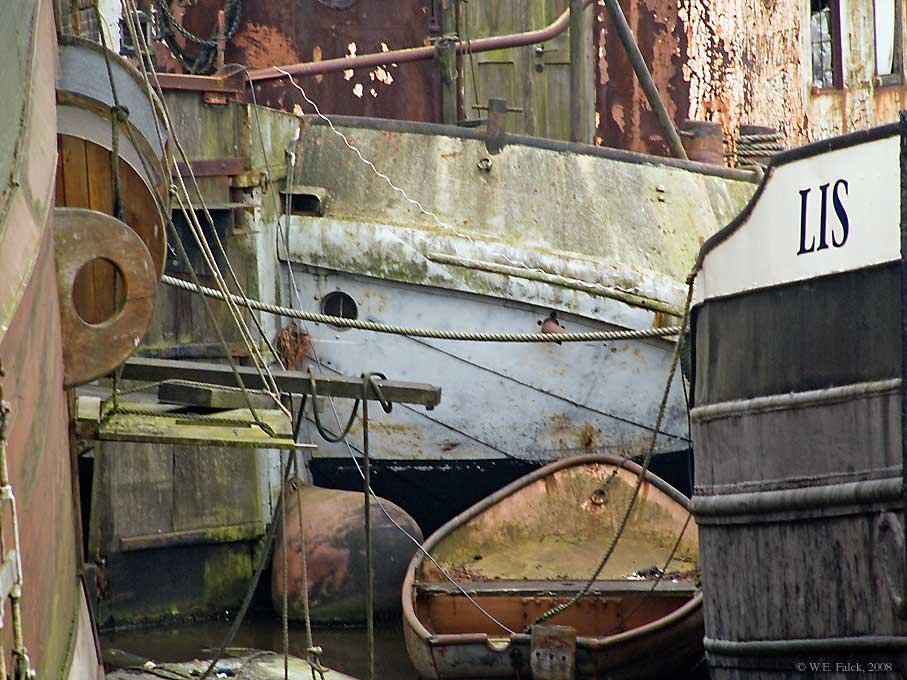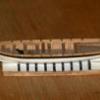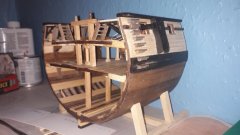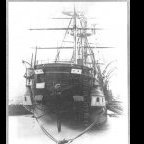MORE HANDBOOKS ARE ON THEIR WAY! We will let you know when they get here.
×
-
Posts
6,475 -
Joined
-
Last visited
Reputation Activity
-
 wefalck reacted to Wintergreen in Atlantica by Wintergreen – Scale 1:30 - POF - sail training ketch - a smack of English heritage
wefalck reacted to Wintergreen in Atlantica by Wintergreen – Scale 1:30 - POF - sail training ketch - a smack of English heritage
Finally feeling reasonable well to sit in front of the computer again!
Without giving away any gory details - it has been a rough week. Period.
Though I'd catch up my log with my actual progress as it stands Sunday before last.
Deck framing is complete.
All frames are secured to the beam shelf with a 19 mm screw bolt, aka 1 mm bamboo tree nail. Actually done after the photo session below.
The entire deck will not need much fairing. The lighter carlings around the main hatch and the forward hatch needed a little shim to sit at correct height. Can not be seen in the photos below.
What is left is to trim some of the timber tops. I will probably add some filler pieces to have support for the waterway and covering board.
There will also be filler pieces/carlings where deck planks are supposed to end. Not all ends land on a deck beam. These will come later I think.
So, this is where it stands at present.
I think I will go out and crank up the heat again in the shop now...
When I know there is a period where I will not be able to go out on a regular basis I set the heat to a minimum, which is 10 degrees to save energy. Otherwise it sits at around 15-16 degrees and with my 400V air heater it is quick work to get a descent 18-20 degrees out there. But starting from 10 is not okay since all the tools will be too cold for comfort.
Pax et bonum!
-

-
 wefalck reacted to Ras Ambrioso in HMS MIMI 1915 by Ras Ambrioso - FINISHED - Scale 1:24 - Fast Motor Launch
wefalck reacted to Ras Ambrioso in HMS MIMI 1915 by Ras Ambrioso - FINISHED - Scale 1:24 - Fast Motor Launch
Th 3 pounder is on its way. I set up my 60 years old Unimat and had a few problems. The raw brass bar that I had for the build would not fit in the headstock opening and, when using the the 3 jaws chuck, the bar was too long, Fortunately I had the steady stand for this lathe . This allowed me to face the end of the bar and drill the centering hole.
After that, the barrel, five millimeters in diameter, fit through the headstock opening and I was able to face and center the fat part of the bar. The the biggest obstacle was to rotate the headstock in order to taper the barrel and the sleeve. The headstock refused to move. It was firmly fused together. Finally, with plenty of penetrating oil, it did and following is the result.
The overall length of the gun is about 102mm. The barrel taper is less than 0.5 degrees going from 5mm dia. to 4mm dia. Next comes the milling of the breech and the drilling for the trunnion.
-
 wefalck reacted to gjdale in The Shipyard at Foss' Landing (Diorama) by gjdale (Grant) - FINISHED - SierraWest - Scale 1:87 (HO)
wefalck reacted to gjdale in The Shipyard at Foss' Landing (Diorama) by gjdale (Grant) - FINISHED - SierraWest - Scale 1:87 (HO)
Thanks again for all the kind comments and likes folks.
The Saw Shed (Continued)
Back to the roofing. We start by constructing the cupola. This is done in exactly the same way as the cupola for the main roof, with carboard substrate/template, prepared timber siding, and the addition of windows with a peeling paint effect. Here are the four sides ready to be glued up.
Next, some purlins are added to the roof to support the roofing sheets.
The roofing sheets received some preliminary preparation with ferric chloride in an earlier post. It was now time to “rust” them up. The instructions were a little vague on this point, “apply some rusty coloured chalk powder”. Perhaps there is an assumption that by this stage we are capable of making our own decisions about how to apply this. Fair enough. I chose three colours to create my version of rust: Rembrandt 235.5 (Orange), 370.5 (Permanent Light Red), and 343.5 (Caput Mortem Red).
My method was as follows:
- tip a generous pile of each of the three colours, well separated from each other, onto my glass work plate
- dip a brush into isopropyl alcohol then remove most of the alcohol on a paper towel
- dip the tip of the brush into the darker colour (343.5) and “blot” onto the roofing sheet.
- while the sheet is still damp, using a DRY brush, blot generous amounts of both the other colours, then shake/tap/lightly brush off the excess.
I’ve no idea whether this method is considered “correct”, but it seemed to work for me. Here are the sheets ready for installation.
The cupola receives its roof first. After installing a couple of support boards between the rafters, the cupola is then fitted. After this picture was taken, I realised I’d done the ridge capping incorrectly and re-did this.
I then proceeded to attach the roofing sheets to the roof. Again, the instructions were a little scant on this, inviting us to simply glue them on. I wasn’t sure what sort of glue to use for this. As I had successfully used PVA to attach the little cupola roof, that’s what I went with. Big mistake. I had all sorts of problems trying to hold pieces in place while the glue set up but pushed ahead regardless. When I finally got all the main pieces on, I went to install the ridge capping and found that PVA just wasn’t going to cut it. So, I went with epoxy for these pieces. Then I went to take some photos to upload to the build log and that’s when the camera made it very obvious that this roofing job was just not up to par.
I though on this overnight and decided that a re-work was in order. A day spent on a re-do is nothing compared to forever looking at a botched job! The main issue was how to deconstruct the roofing without destroying the rest of the building. As I’d used epoxy on the ridge capping, I needed to use acetone to de-bond those pieces. That went quite quickly, and they came off without too much trouble at all. To de-bond the main roofing sheets, I used isopropyl alcohol, being as careful as I could not to inadvertently de-bond any major structural components. In the end, it was only the purlins that came away with the roofing sheets. Oh, and the cupola kinda fell apart too. The only real downside was that although I’d successfully removed the roof sheeting, the process also took off most of the rust colouring, so I had to re-do that (using the same process described earlier). Unfortunately, I didn’t take any photos during the deconstruction phase.
Having re-built the cupola and re-coloured all my roofing sheets, I decided to try a different approach to gluing and broke out the CA gel. I don’t normally like to use CA glue in any form as I have a sensitivity to it and develop flu-like symptoms at the slightest exposure. But, there was not readily apparent alternative, so I put on my big boy pants and got on with it. This time the whole process went quickly and easily and before I knew it, I had the roof back on. The final job was to put some “flashing” around the base of the cupola. The instructions say to use epoxy coloured with some paint as we’ve used earlier on, but I find this a little messy to apply. So, taking a tip from another build log, I decided to use some PVA coloured with a little paint and applied using a syringe. That seemed to work quite well and once dry I “painted” some black and grey chalk powder with a little alcohol to dull down the shine and leave a nice dark grey flashing.
Here are some pictures of the completed shed.
The next task will be to start work on the diorama base – another “totally new to me” excursion…
-
 wefalck got a reaction from robert952 in All our problems are solved: post your dodgy solutions
wefalck got a reaction from robert952 in All our problems are solved: post your dodgy solutions
When I read this correctly, then only plans for 'ground trainers' are offered, which I would interpret as non-flying - would reduce the risk considerably.
I am not into flying, but seem to remember having read that in the 1930s and even into the 1950s glider enthusiast build their own gliders - the Wasserkuppe mountain in Germany was one of the centres for glider flying at the time.
And you can see various videos on YouTube etc. where people built oversized 'drones' and fly with them (of course they are not drone anymore then ...). Due to tight airspace-regulations and a lack of free space this seems to happen more in remote areas and not in Europe.
-
 wefalck got a reaction from mbp521 in All our problems are solved: post your dodgy solutions
wefalck got a reaction from mbp521 in All our problems are solved: post your dodgy solutions
When I read this correctly, then only plans for 'ground trainers' are offered, which I would interpret as non-flying - would reduce the risk considerably.
I am not into flying, but seem to remember having read that in the 1930s and even into the 1950s glider enthusiast build their own gliders - the Wasserkuppe mountain in Germany was one of the centres for glider flying at the time.
And you can see various videos on YouTube etc. where people built oversized 'drones' and fly with them (of course they are not drone anymore then ...). Due to tight airspace-regulations and a lack of free space this seems to happen more in remote areas and not in Europe.
-
 wefalck got a reaction from thibaultron in All our problems are solved: post your dodgy solutions
wefalck got a reaction from thibaultron in All our problems are solved: post your dodgy solutions
When I read this correctly, then only plans for 'ground trainers' are offered, which I would interpret as non-flying - would reduce the risk considerably.
I am not into flying, but seem to remember having read that in the 1930s and even into the 1950s glider enthusiast build their own gliders - the Wasserkuppe mountain in Germany was one of the centres for glider flying at the time.
And you can see various videos on YouTube etc. where people built oversized 'drones' and fly with them (of course they are not drone anymore then ...). Due to tight airspace-regulations and a lack of free space this seems to happen more in remote areas and not in Europe.
-
 wefalck got a reaction from mtaylor in All our problems are solved: post your dodgy solutions
wefalck got a reaction from mtaylor in All our problems are solved: post your dodgy solutions
When I read this correctly, then only plans for 'ground trainers' are offered, which I would interpret as non-flying - would reduce the risk considerably.
I am not into flying, but seem to remember having read that in the 1930s and even into the 1950s glider enthusiast build their own gliders - the Wasserkuppe mountain in Germany was one of the centres for glider flying at the time.
And you can see various videos on YouTube etc. where people built oversized 'drones' and fly with them (of course they are not drone anymore then ...). Due to tight airspace-regulations and a lack of free space this seems to happen more in remote areas and not in Europe.
-
 wefalck got a reaction from king derelict in The Shipyard at Foss' Landing (Diorama) by gjdale (Grant) - FINISHED - SierraWest - Scale 1:87 (HO)
wefalck got a reaction from king derelict in The Shipyard at Foss' Landing (Diorama) by gjdale (Grant) - FINISHED - SierraWest - Scale 1:87 (HO)
How will the saw be driven? Seems to call for a horizontal steam-engine ...
I love this project. These wooden buildings have a lot of character!
-
 wefalck got a reaction from bruce d in All our problems are solved: post your dodgy solutions
wefalck got a reaction from bruce d in All our problems are solved: post your dodgy solutions
When I read this correctly, then only plans for 'ground trainers' are offered, which I would interpret as non-flying - would reduce the risk considerably.
I am not into flying, but seem to remember having read that in the 1930s and even into the 1950s glider enthusiast build their own gliders - the Wasserkuppe mountain in Germany was one of the centres for glider flying at the time.
And you can see various videos on YouTube etc. where people built oversized 'drones' and fly with them (of course they are not drone anymore then ...). Due to tight airspace-regulations and a lack of free space this seems to happen more in remote areas and not in Europe.
-
 wefalck got a reaction from Jack12477 in All our problems are solved: post your dodgy solutions
wefalck got a reaction from Jack12477 in All our problems are solved: post your dodgy solutions
When I read this correctly, then only plans for 'ground trainers' are offered, which I would interpret as non-flying - would reduce the risk considerably.
I am not into flying, but seem to remember having read that in the 1930s and even into the 1950s glider enthusiast build their own gliders - the Wasserkuppe mountain in Germany was one of the centres for glider flying at the time.
And you can see various videos on YouTube etc. where people built oversized 'drones' and fly with them (of course they are not drone anymore then ...). Due to tight airspace-regulations and a lack of free space this seems to happen more in remote areas and not in Europe.
-
 wefalck got a reaction from FriedClams in Germania Nova 1911 by KeithAug - FINISHED - Scale 1:36 - replica of schooner Germania 1908
wefalck got a reaction from FriedClams in Germania Nova 1911 by KeithAug - FINISHED - Scale 1:36 - replica of schooner Germania 1908
Well, failing that, we would be content with some progress report on his railway adventures ...
-
 wefalck got a reaction from FriedClams in The Shipyard at Foss' Landing (Diorama) by gjdale (Grant) - FINISHED - SierraWest - Scale 1:87 (HO)
wefalck got a reaction from FriedClams in The Shipyard at Foss' Landing (Diorama) by gjdale (Grant) - FINISHED - SierraWest - Scale 1:87 (HO)
Looking very nice, well done 👍
One thing that puzzles me, however, is the orientation of the saw-blade versus the rollers. I would have expected that the rollers feed (planks) into the saw-blade ...
And a little technical detail: the ends of leather drive-belts were attached with special metal 'agraffes' and they don't overlap. If they did overlap there is a jump and slip on the pulleys.
Sorry to say, but I am bit disappointed over technological progress - a boring electric motor and not a little horizontal steam-engine, the boiler of which is fed with saw-dust and off-cuts
-
 wefalck reacted to KeithAug in Germania Nova 1911 by KeithAug - FINISHED - Scale 1:36 - replica of schooner Germania 1908
wefalck reacted to KeithAug in Germania Nova 1911 by KeithAug - FINISHED - Scale 1:36 - replica of schooner Germania 1908
Im getting annoyed with myself that i am not finishing off this build, but thanks to everyone for sticking with me. I suppose that I was having and aversion to fixing mistakes but this weekend I managed to overcome my prevarication and fixed the problem.
As I previously said the upper fore mast back stay had been rigged as a fixed stay. During a discussion on the complexity of tacking the fisherman it became obvious that I should have fitted a pair of running back stays with only the windward stay taking the load. Although I hadn't fitted a fisherman the change was made necessary by the nagging voice in my head. The change necessitated the production of 5 more twin blocks (one of which I managed to misplace).
I found the 5th after a half hour hunt!!!!!!!!!!
The fixed stay was removed and replaced by a pair of back stays wrapped around the upper fore mast,
The pair were led to the twin block mounted high on the main mast.
I had to remove a couple of deck hard points to mount the blocks - luckily they were glued in with CA and came free neatly with the application of a soldering iron. See hole next to the uppermost hand wheel. I managed to knock the hand wheel off (its smaller than it looks) and spent a good hour getting it back on - idiot!!!
Rigging the blocks was the easy bit - but just twice ad difficult as it would have been had it got it right in the first place.
It now feels fixed but most people won't notice.
I also made some progress on the flags but dinner is ready so that will have to wait until next time.
-
 wefalck got a reaction from mtaylor in Germania Nova 1911 by KeithAug - FINISHED - Scale 1:36 - replica of schooner Germania 1908
wefalck got a reaction from mtaylor in Germania Nova 1911 by KeithAug - FINISHED - Scale 1:36 - replica of schooner Germania 1908
Well, failing that, we would be content with some progress report on his railway adventures ...
-
 wefalck reacted to allanyed in Germania Nova 1911 by KeithAug - FINISHED - Scale 1:36 - replica of schooner Germania 1908
wefalck reacted to allanyed in Germania Nova 1911 by KeithAug - FINISHED - Scale 1:36 - replica of schooner Germania 1908
I totally agree and would bet there are a lot of members that feel the same.
Allan
-
 wefalck got a reaction from Glen McGuire in The Shipyard at Foss' Landing (Diorama) by gjdale (Grant) - FINISHED - SierraWest - Scale 1:87 (HO)
wefalck got a reaction from Glen McGuire in The Shipyard at Foss' Landing (Diorama) by gjdale (Grant) - FINISHED - SierraWest - Scale 1:87 (HO)
Looking very nice, well done 👍
One thing that puzzles me, however, is the orientation of the saw-blade versus the rollers. I would have expected that the rollers feed (planks) into the saw-blade ...
And a little technical detail: the ends of leather drive-belts were attached with special metal 'agraffes' and they don't overlap. If they did overlap there is a jump and slip on the pulleys.
Sorry to say, but I am bit disappointed over technological progress - a boring electric motor and not a little horizontal steam-engine, the boiler of which is fed with saw-dust and off-cuts
-
 wefalck got a reaction from Canute in The Shipyard at Foss' Landing (Diorama) by gjdale (Grant) - FINISHED - SierraWest - Scale 1:87 (HO)
wefalck got a reaction from Canute in The Shipyard at Foss' Landing (Diorama) by gjdale (Grant) - FINISHED - SierraWest - Scale 1:87 (HO)
Looking very nice, well done 👍
One thing that puzzles me, however, is the orientation of the saw-blade versus the rollers. I would have expected that the rollers feed (planks) into the saw-blade ...
And a little technical detail: the ends of leather drive-belts were attached with special metal 'agraffes' and they don't overlap. If they did overlap there is a jump and slip on the pulleys.
Sorry to say, but I am bit disappointed over technological progress - a boring electric motor and not a little horizontal steam-engine, the boiler of which is fed with saw-dust and off-cuts
-
 wefalck got a reaction from mtaylor in The Shipyard at Foss' Landing (Diorama) by gjdale (Grant) - FINISHED - SierraWest - Scale 1:87 (HO)
wefalck got a reaction from mtaylor in The Shipyard at Foss' Landing (Diorama) by gjdale (Grant) - FINISHED - SierraWest - Scale 1:87 (HO)
Looking very nice, well done 👍
One thing that puzzles me, however, is the orientation of the saw-blade versus the rollers. I would have expected that the rollers feed (planks) into the saw-blade ...
And a little technical detail: the ends of leather drive-belts were attached with special metal 'agraffes' and they don't overlap. If they did overlap there is a jump and slip on the pulleys.
Sorry to say, but I am bit disappointed over technological progress - a boring electric motor and not a little horizontal steam-engine, the boiler of which is fed with saw-dust and off-cuts
-
 wefalck got a reaction from Old Collingwood in The Shipyard at Foss' Landing (Diorama) by gjdale (Grant) - FINISHED - SierraWest - Scale 1:87 (HO)
wefalck got a reaction from Old Collingwood in The Shipyard at Foss' Landing (Diorama) by gjdale (Grant) - FINISHED - SierraWest - Scale 1:87 (HO)
Looking very nice, well done 👍
One thing that puzzles me, however, is the orientation of the saw-blade versus the rollers. I would have expected that the rollers feed (planks) into the saw-blade ...
And a little technical detail: the ends of leather drive-belts were attached with special metal 'agraffes' and they don't overlap. If they did overlap there is a jump and slip on the pulleys.
Sorry to say, but I am bit disappointed over technological progress - a boring electric motor and not a little horizontal steam-engine, the boiler of which is fed with saw-dust and off-cuts
-
 wefalck got a reaction from Edwardkenway in The Shipyard at Foss' Landing (Diorama) by gjdale (Grant) - FINISHED - SierraWest - Scale 1:87 (HO)
wefalck got a reaction from Edwardkenway in The Shipyard at Foss' Landing (Diorama) by gjdale (Grant) - FINISHED - SierraWest - Scale 1:87 (HO)
Looking very nice, well done 👍
One thing that puzzles me, however, is the orientation of the saw-blade versus the rollers. I would have expected that the rollers feed (planks) into the saw-blade ...
And a little technical detail: the ends of leather drive-belts were attached with special metal 'agraffes' and they don't overlap. If they did overlap there is a jump and slip on the pulleys.
Sorry to say, but I am bit disappointed over technological progress - a boring electric motor and not a little horizontal steam-engine, the boiler of which is fed with saw-dust and off-cuts
-
 wefalck got a reaction from Jack12477 in The Shipyard at Foss' Landing (Diorama) by gjdale (Grant) - FINISHED - SierraWest - Scale 1:87 (HO)
wefalck got a reaction from Jack12477 in The Shipyard at Foss' Landing (Diorama) by gjdale (Grant) - FINISHED - SierraWest - Scale 1:87 (HO)
Looking very nice, well done 👍
One thing that puzzles me, however, is the orientation of the saw-blade versus the rollers. I would have expected that the rollers feed (planks) into the saw-blade ...
And a little technical detail: the ends of leather drive-belts were attached with special metal 'agraffes' and they don't overlap. If they did overlap there is a jump and slip on the pulleys.
Sorry to say, but I am bit disappointed over technological progress - a boring electric motor and not a little horizontal steam-engine, the boiler of which is fed with saw-dust and off-cuts
-
 wefalck got a reaction from Keith Black in The Shipyard at Foss' Landing (Diorama) by gjdale (Grant) - FINISHED - SierraWest - Scale 1:87 (HO)
wefalck got a reaction from Keith Black in The Shipyard at Foss' Landing (Diorama) by gjdale (Grant) - FINISHED - SierraWest - Scale 1:87 (HO)
Looking very nice, well done 👍
One thing that puzzles me, however, is the orientation of the saw-blade versus the rollers. I would have expected that the rollers feed (planks) into the saw-blade ...
And a little technical detail: the ends of leather drive-belts were attached with special metal 'agraffes' and they don't overlap. If they did overlap there is a jump and slip on the pulleys.
Sorry to say, but I am bit disappointed over technological progress - a boring electric motor and not a little horizontal steam-engine, the boiler of which is fed with saw-dust and off-cuts
-
 wefalck reacted to Hubac's Historian in Soleil Royal by Hubac's Historian - Heller - An Extensive Modification and Partial Scratch-Build
wefalck reacted to Hubac's Historian in Soleil Royal by Hubac's Historian - Heller - An Extensive Modification and Partial Scratch-Build
I have painted and distressed the corbels and the upper window tier.
I found myself swearing early and often, as I repeatedly broke off the doors from the window tier. There isn’t much plastic connecting them, and until they’re glued into the model, they are exceptionally fragile.
I appreciate the tip, T_C, but presumably my bitumen is making its long journey across the Atlantic like the swarthy pilgrim it is. As I wait, I continue to construct the stern. I made up and fitted the next transom header, so that I can glue-in the window tier:
Although the winding out of square continues, it does so marginally and the eye really doesn’t see it:
With the header in-place, I could begin to focus on the design of the most challenging aspect of the decor: as the French call it - the Couronnement. It is somewhat hilarious to me that after all of this effort to make the hull wider, the tafferal ends up being only fractionally wider than the stock stern plate:
This development is the result of fashioning the internal gussets that support the aft bulwarks, at an angle that promoted a more realistic tumblehome for the after castle; the stock kit is a little more vertically slab-sided in its approach to this detail. Here, you can see the comparison between the tafferal width I thought I’d have (at the start of the project) and where I ended up:
Despite this not un-satisfactory development, Tanneron and Heller (following suit) chose to represent the backboard (tafferal) as improbably tall for the refit of 1689. So, in other words, I was going to have to re-fashion this area anyway.
Towards that end, much earlier in my modification of the upper bulwarks, I cut away the poop royal sheer-step (5/16”+), only to replace it by 1/2 that height of a more realistic, low, sheer rail that is more reflective of the times:
However, the more significant shortening of the tafferal comes from lowering the side support for the outer lanterns, so that they are aligned with the sheer rail, as opposed to above it.
The first step was to re-draw the goose-neck cornice because I never liked Heller’s interpretation of this detail:
Next, I had to define the field for Apollo and his quadriga, which meant defining the height for the bar of astrological symbols along the top. On the stock kit, these are a continuation of the side lantern supports which I will re-cycle for this build. However, to follow the height of those boxes does not leave me with a large enough field for the main carving, below; see the dotted line proposed in the upper right. So, I decided to cheat that line upward about a 1/16”. It will necessitate hand-painting these astrologic symbols into these tiny paneled recesses, but that is okay.
The really good news is that I will be able to re-shape the swagging vestments of Europe and Asia to fit the new cornice shape:
This is really great because, as it is, I have to re-carve The Americas and Africa because the stock figures are too tall and Africa has the wrong posture.
The next task was to see whether my original drawing of Apollo could be reduced enough to reasonably fit my field. Here is the full-size drawing:
I did a series of reductions, at 50, 60, and 70%. Seventy percent was close:
As compared to the kit carving:
But, I felt it encroached too much on the upper and lower boundaries of the field. I settled on 67%:
As compared with Berain’s drawing:
I’m not totally satisfied with the scrolled vollute. It’s too big. I’ll have to re-work the clouds to conform more neatly with the lower moulding, but I am happy with the scale of Apollo and his horses.
It is not as wide as Berain drew it, but this will allow me to better create my gradient sky from light cerulean blue to dark azurite, up top. radiating outward in all directions, from behind Apollo will be fine needles of sun-light in gold and silver gilt. Apollo and his horses will be all gold and the clouds will be temperamentally white and grey. Once I am satisfied with the scroll, I can photocopy the drawing and make a reverse copy, so that the port side can be matched to its mirror for a perfectly symmetrical pattern.
My motivation is to have the stern fully framed and perhaps even painted by the time of Joint Clubs on April 30th. I think this would be a satisfying resolution to everything that came below:
In other news and notes, I have made satisfying in-roads into Dassie’s Architecture Navale. I now have a pretty solid understanding of the proportional derivation of the principal elements of a ship, although there is still much translating to do. This essentially amounts to re-typing all relevant passages into Google Translate because the photo capture feature never results in nearly as intelligible a translation as the more tedious path. My French is improving though, as a result, and full transcriptions are becoming less necessary as I develop a vocabulary of French ship nomenclature.
I am simultaneously doing the same translation work on the 1685 Le Have du Grace dimensional survey of what is presumed to be the pre-refit Soleil Royal. It is extremely helpful that this document (which I downloaded from Gallica) has a numbered drawing that details all of the principal parts of a ship and it’s framing.
What is fascinating is that the neither Le Havre du Grace nor Dassie’s prescriptive formulas correspond with what was supposed to be SR’s original length of keel:
As built: 142’
Le Havre du Grace: 140”
Dassie: 136’
I have been applying Dassie’s formulas to SR’s particulars, as I go, and ultimately I will have a more complete comparison with the Le Havre de Grace document. This is all ground previously tread by Michel Saunier, and in-fact, I still have a copy of his exhaustive tabulation of all the dimensions of every aspect of the ship. He emailed this to me years ago. I still think this is a worthwhile exercise, though, to better understand how he arrived at where he did with his model.
Anyway, it keeps me occupied. Thank you for your interest, your likes and your comments. More to follow!
-
 wefalck got a reaction from Canute in Acrylic paint tips and techniques
wefalck got a reaction from Canute in Acrylic paint tips and techniques
Acrylic paints are complex emulsions with either water, or alcohol or a mixture of both as solvents. They may also contain surfactants as emulsifiers. Emulsions are very delicate things and can easily break down when using the wrong solvents, resulting in curdling with resulting clogging of the airbrush for instance. In such cases they also do not form the cross-linked network of acrylic molecules that form the paint layer.
It appears that Vallejo uses a relatively simple system that can be diluted with water, dito. for the German Schmincke paints. I do not have experience with products of other manufacturers.












